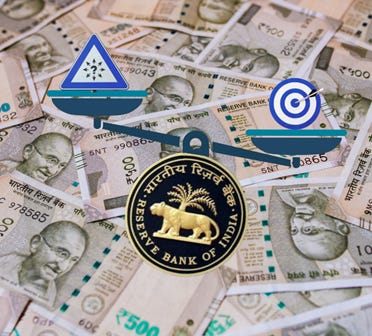India’s Paradox of Policy Fog: Why Uncertainty Cools Inflation Fears
Uncertainty lowers inflation expectations even as it slows demand, showing why communication and credible institutions matter for growth.
View as PDF
Debasis Rooj, FLAME University.
Anurag Banerjee, OP Jindal Global University.
Reshmi Sengupta, FLAME University.
SDG 8: Decent Work and Economic Growth | SDG 16: Peace, Justice and Strong Institution
Institutions: Reserve Bank of India | Ministry of Finance
When policy signals turn muddled, Indian families do not fear runaway inflation. Instead, they often expect prices to rise more slowly – and postpone big-ticket purchases. This counter-intuitive response reveals a deeper truth: in India, ambiguity tends to depress confidence rather than igniting panic. For policymakers, it is a reminder that credibility and communication matter as much as interest rates in shaping economic behaviour.
Inflation Expectations: The Invisible Driver
Inflation expectations are invisible but powerful. They shape whether a family dips into savings to buy a refrigerator today, whether workers press for higher wages, and whether businesses invest in a new capacity. In standard economic reasoning, if people believe prices will rise, they tend to spend sooner; if they expect stability, they hold back. For the Reserve Bank of India (RBI), which adopted formal inflation targeting in 2016, anchoring these expectations is central to maintaining price stability.
Economic policy uncertainty – essentially, how unpredictable government decisions appear – works in the opposite direction. It is captured by measures such as the Economic Policy Uncertainty Index, which counts how often terms related to the economy, policy and uncertainty appear in major newspapers – a widely-used proxy for the uncertainty that shapes public perceptions and decisions. A rising index signals public doubt about the government’s fiscal, monetary or regulatory direction.
Evidence from Urban Surveys
The natural assumption is that when policies appear uncertain, citizens brace for turbulence and expect prices to surge. Survey evidence from India over the past decade and a half, however, points in a different direction..
The RBI’s household surveys, conducted quarterly across 19 cities, provide over 420,000 responses between 2008 and 2024 on expected inflation for the leading three months and the year ahead. When these expectations are compared with measures of policy ambiguity, a consistent pattern emerges: higher uncertainty is associated with lower short-term inflation expectations.
The relationship is not confined to isolated episodes. It holds when uncertainty is measured differently, including with a Google search-based index of fiscal and monetary ambiguity. Even global policy uncertainty, drawn from 21 countries, shows similar effects on Indian consumers. Placebo tests with randomised data reveal no such link, suggesting that the association is robust rather than merely coincidental..
The effect is economically meaningful. A one standard-deviation rise in the uncertainty index – roughly the kind of jump seen during a major policy announcement or global shock – lowers households’ short-term inflation expectations by about 0.2 percentage points. That is roughly the same as the difference between petrol prices staying flat for a few months versus edging up, enough to make families delay a car purchase or hold back on home improvements.
A Social and Precautionary Lens on Inflation Expectations
Beyond averages, the surveys also reveal who feels policy fog most acutely. Women – often managing household budgets – lower their short-term inflation expectations by about 0.3 percentage points more than men when policy uncertainty rises. That is roughly the difference between expecting vegetables to cost the same at the next market trip versus rising by a few rupees, a small shift on paper but meaningful when multiplied across weekly purchases.
There are other group-level differences too. The self-employed, whose incomes are less predictable, tend to cut their short-term inflation expectations by about 0.25 percentage points more than salaried workers when uncertainty rises. But the pattern is not uniform: in some cases they even expect higher inflation, anticipating that fuel or raw material costs will climb – the kind of shift that, for a small shopkeeper, can mean the difference between breaking even and running at a loss.
Middle-aged earners, often juggling the costs of raising children while supporting ageing parents, report lowering their inflation expectations by around 0.2 to 0.25 percentage points more than younger or retired respondents when uncertainty rises. For a household in this age bracket, that shift can mean postponing a decision on a housing loan or delaying university fee payments, choices that ripple across both present and future plans.
The pattern is clearest across the consumption basket. Expectations for house prices and durable goods fall almost twice as much as for food or services when policy uncertainty rises. In practice, that means families may still budget for groceries or electricity bills, but hold back on buying a car or upgrading their home – delays that shift thousands of rupees of spending out of the economy.
These differences reflect India’s social and economic realities. Inflation expectations, if left unmanaged, can magnify stress. It can discourage compliance with welfare programmes, deter long-term investments in housing or education, and erode trust in institutions. Conversely, if managed constructively, it can ease anxieties and reinforce legitimacy by showing that citizens’ concerns are anticipated and addressed.
These numbers are not benign. Durable consumption and housing are crucial engines of employment and growth. When families hold back on these purchases, the slowdown ripples through construction, manufacturing and services.
Why This Matters for India’s Policy Framework
The paradox that uncertainty cools inflation expectations has far-reaching consequences. Inflation targeting depends not only on official decisions about interest rates, but also on how citizens interpret the wider policy climate. If fiscal or regulatory ambiguity lowers expected inflation, it may restrain demand at precisely the time when the economy needs consumers to spend.
The effect is not limited to the short term. When uncertainty spikes, households lower their inflation expectations for the next three months or a year. But if the fog lingers, those expectations can gradually turn upwards, as families begin to anticipate higher costs ahead. Policymakers therefore face a double challenge: cushioning the immediate cooling of demand while also guarding against the risk of longer-term destabilisation.
The issue reaches beyond the RBI. Fiscal policy, tax administration, subsidies and regulatory changes all feed into consumer perceptions. Ambiguity in one arm of government can undercut credibility in another. What matters is not only the content of policy but whether it signals direction and consistency.
Managing Uncertainty Constructively: A Forward-Looking Agenda
Uncertainty cannot be eliminated entirely in a dynamic economy. But it can be managed.
Clear communication is the first line of defence. When the RBI explains its decisions in plain language and signals its future intentions, families gain confidence even if interest rates rise. When finance ministries outline fiscal strategies with credible timelines, citizens can plan around them. By contrast, sudden announcements without explanation deepen anxiety; gradual, well-signalled shifts are easier to absorb.
Coherence across institutions is equally important. When monetary, fiscal and regulatory authorities appear to pull in different directions, they send mixed signals. Aligning objectives and communicating them consistently reduces the fog.
Credibility is the anchor. If institutions are trusted to act independently and predictably, temporary ambiguity matters less. Protecting the autonomy of the RBI, maintaining fiscal discipline, and upholding regulatory stability are all critical for anchoring expectations.
Communication must also reach beyond elite circles. English-language newspapers and business media cannot carry the full burden of explaining policy. Vernacular channels, digital platforms and community networks can play a stronger role in carrying messages deeper, helping reduce the information gaps that magnify anxiety.
Managing uncertainty is as much about trust as it is about targets – and that is the lesson policymakers can no longer afford to ignore.
View as PDF
Authors:

The discussion in this article is based on authors’ research published in India Growth and Development Review (2025). Views are personal.


